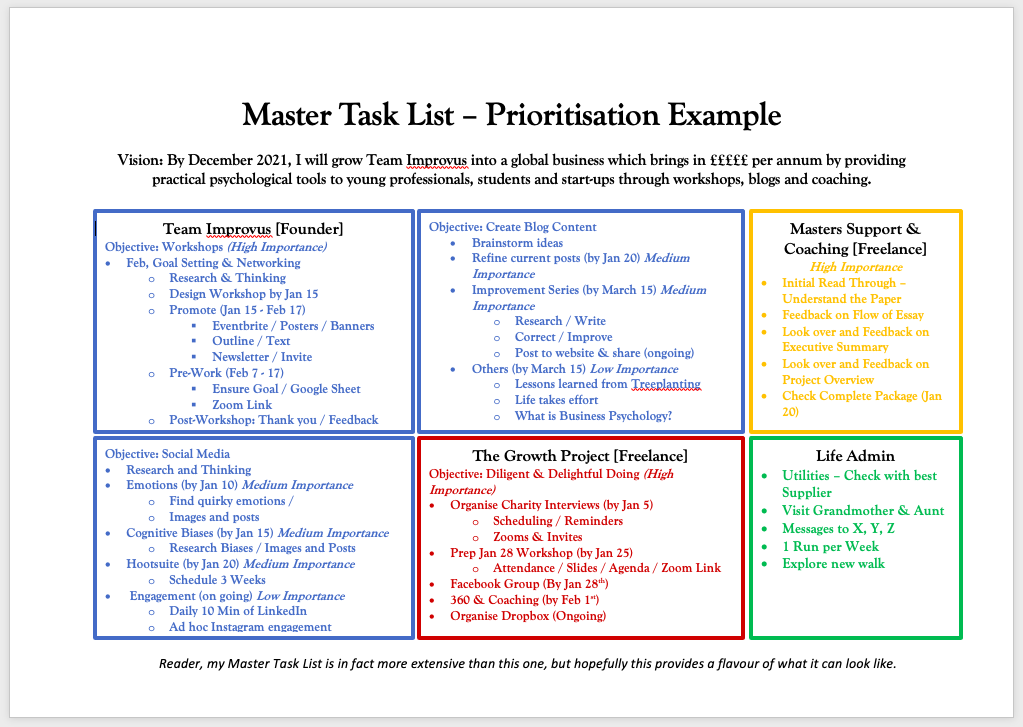
Prioritisation - The Heart of Productivity
Hello Reader,
Prioritisation is the heart of productivity.
If we prioritise effectively, we can maximise our time and ensure we are focusing our energy for greatest impact. Now, before we actually dive into prioritising our tasks, we need to lay the groundwork by articulating our vision and creating a master task list. These two steps make sure we have an unblinkered view of our direction and are clear on all the actions which need to get done. It means we can prioritise with our eyes wide open, instead of prioritising in the dark.
How much Time is needed for this exercise?
The first few times I did this exercise, it took me approximately three hours. That being said, I had just started up my own business and was new to my role as a founder and freelancer. The unfamiliarity meant that it took me a while to understand my vision and all the tasks I needed to accomplish. Nowadays, the process takes me between 15 to 90 minutes because I have become more experienced in my role and have instilled this habit as a monthly routine, thus honing my skills.
If you already know your vision and have a master task list, then please jump down to the Rate your Tasks section.
Start with Vision
The first step in prioritisation is knowing our vision, our goal. We need to know what we are working towards in order to prioritise the tasks which are most important to that destination. I believe prioritisation without an end goal is just aimless busyness - completing tasks for sake of ticking them off. Prioritising effectively requires a vision to act as our rudder, steering us in the right direction.
If you are struggling to articulate your vision, feel free to reference my post on How to Know your Vision; which includes a template I use for my business, as well as other questions to help find direction.
Master Task List
The second step of prioritisation is creating a master task list; a place where we identify all of our upcoming actions. This list is vital for prioritisation because it provides a full picture of what needs to get done and ensures we are not forgetting anything.
*Note, this exercise can be daunting and overwhelming. Once we see all of our tasks laid out in front of us, it can seem like a significant amount … take that deep breath and look forward to having more clarity of how to manage the various actions on your plate.
Rate your Tasks
Excellent, now we are onto the actual rating step! What we need to do is prioritise our tasks according to the following variables.
Importance - how much value does this task have to my vision?
Deadline - if the task has a deadline, note that down.
Responsibility - if you are a leader, check if the task can be delegated to others.
Additional Variables - add any other variables that are relevant for the weighing of your tasks.
Example
*An extra insight we can add to the mix is estimating how long a given task will take. Knowing roughly how much time an action will take allows us to plan accordingly and be as effective as we can be with our time.
Reference the Tasks Regularly
The final step in my prioritisation strategy is to reference my master task list regularly. There is no point in putting in all this effort to get organised if we don’t use it to guide our work. So, I create a daily plan of action from my task list which keeps me focused and productive. Learn how to design your Daily Plan in this post.
Excellent, enjoy the prioritisation process and let me know if it works for you or if you have any ways to improve it.
Happy Doing!
Helping Young Professionals & Postgraduate Students Improve
Extras
“The key is not to prioritize what’s on your schedule but to schedule your priorities.” - Stephen Covey
Eat the Frog
The analogy, from Mark Twain, is that we put the most difficult first so that we can do it with energy and focus. We don’t move onto the next task until the first one is done.
Eisenhower Matrix - Level of Urgency & Importance
From our Master To-Do List, we can use the Eisenhower Matrix to map out our prioritisation. The table shows which items are high on importance and high urgency, and then continues down the levels of urgency and importance, thus providing us with a clearer understanding of where to begin.




